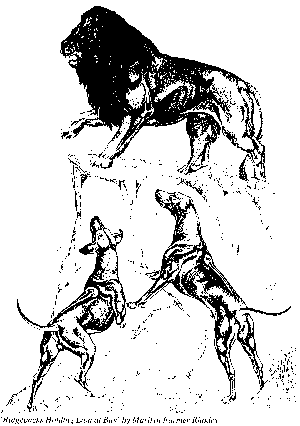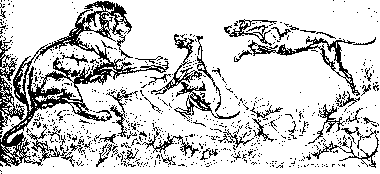We would like to present the breed's history in a nutshell, as we know that Rhodesian Ridgeback is still quite unknown name for the people.
RR's personality and for whom RRs are.
 |
RR belongs to 6th group of FCI - hounds. The breed is also known as Lion Dogs or Rhodesian Lion Hounds and originated in South Africa. Rhodesians' distinctive and very unique feature (only two dog breeds in the world have it) is the ridge at the back: the hair on the dog's spine grows in the opposite direction to the rest of the coat. The ridge looks like a sword with a "hilt" i.e. two symetrically located crowns (whorls) between the shoulder blades; tapering as it continues to a sharp end on the rump or slightly before it. The distinctive ridge contributed to the breed's name: Ridgeback. Another breed sharing this peculiar feature with Rhodesians is Thai Ridgeback. However, the breed standard for Rhodesians states clearly what the ridge should look like and how long it must be. Each variation to the standard is treated as a fault and the dog cannot be recognized as a pedigree dog for breeding. RRs derive from primitive native dogs bred by Hottentots in southern Africa and originally they were small-medium sized (45cm) hunting ones with a ridge of hair turned forward on their spine. At the beginning of the 17th century they were crossed with big hunting dogs and molosses brought to Africa by Dutch colonists. Out of various crosses the ones with the ridge turned out to be the most immune as well as the best hunters and guards and as such they were chosen for further breeding. The first Lion Dog Club was extablished in 1902 and twenty years later, in 1922 the official name of the breed was changed into Rhodesian Ridgeback. In the same year the standard for the breed was recognized in Rhodesia (today's Zimbabwe) and in 1924 South Africa Kennel Union and other states all over the world recognized the breed officially. |
RR's personality and for whom RRs are.
-
A typical ridgeback is non-aggressive, even-tempered with a high threshold of excitement.
-
Communicative, subordinate and recognizing human authority as a result of close cooperation between these two since the very beginning. The dogs have always waited cornered the game only and waited for the hunter to kill.
-
RRs are very courageous, ready to fight and defend if there is such need, but they are not militant so they do not match people who want these dogs' power and courage to compensate for their complexes.
-
Excellent guardians even if they have not been trained. Distrustful towards strangers. Safe: their goal is to corner and hold the intruder back, not to bite to death.
-
Affectionate, unlimitedly devoted to the family, tolerant and patient with children.
-
Mentally sensitive - this is not a breed for strict, excessively despotic, nervous or hesitant people.
-
A partner and a friend - not a blind humble servant. Being a hound an RR shows independence and initiative, sometimes a bit of obstinacy, but - if well brought up and loving its master - it will fulfil all his/her wishes.
-
RRs need close contact with humans, looking up to their masters they simply crave for their closiness.
-
A sociable, family dog, which would be deeply hurt if put to a pen !
-
Being a hound an RR needs a lot of movement and activity. Especially young dogs show a lot of temperament and unlimited loads of energy. As far as speed and movement needs they can be compared to Thoroughbred Horses. Speed record kept in Britain: 300m/21sec.; in Australia: 400m/30.8sec. Apart from the master, movement means everything for this dog. Movement determined once RRs' chances for survival and at present it is vital for the dogs' proper mental and physical development.
-
RRs are dogs for energetic, active, physically and mentally strong, patient and consistent people, who have a lot of free time, vitality and like exercise out of doors.
-
RRs are intelligent, eager to learn and, when properly trained, they are strictly obedient.
-
Easy to tend (short sleek coat), clean and having a very subtle, namely faint smell, typical for the breed.



